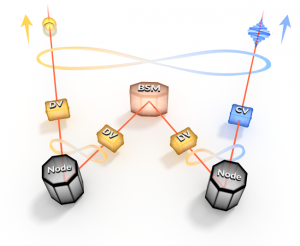Connecting the quantum internet
Researchers at the Kastler Brossel Laboratory in Paris have succeeded in implementing a novel “hybrid” entanglement swapping protocol, bringing within reach the connection of disparate platforms in a future, heterogeneously-structured, quantum internet.
In the May 29th online issue of Science Advances, Prof. Julien Laurat and his colleagues at LKB (Sorbonne Université, CNRS, ENS-Université PSL, Collège de France), with collaborators at NIST Boulder, announce an important step towards the development of heterogeneous quantum networks. The team has demonstrated a way of connecting different types of quantum nodes that are not necessarily based on the same type of encoding. Enabling such a type of link is a crucial requirement for the interconnection of different physical platforms that can perform dedicated quantum-enhanced tasks.
Quantum networks are composed of quantum systems located at distant nodes and connected via non-classical correlations known as entanglement – the “spooky action at a distance”. They are believed to outperform current classical networks in tasks ranging from quantum-secure communication to enhanced measurements. Similarly to classical networks – where information can be encoded in two distinct digital or analog encodings depending on the tasks at hand – quantum networks can rely on two types of encodings, as exemplified by the particle-wave duality. On the one hand side one can favor the particle nature of the quantum bits (or qubits), in an encoding similar to the digital one and referred to as “discrete-variable”. On the other hand, one might prefer using the “continuous-variable”, analog-like, encoding which spurs from the wavy nature of the particles – a well-known consequence of quantum mechanics.
In quantum networks, the connection of distant nodes is performed by a specific operation called entanglement swapping. This procedure allows to connect systems that have never interacted before by using a specialized measurement between two other resources separately entangled with the systems involved. This operation, known as Bell-state measurement, effectively transfers – or “teleports” – the entanglement to the final systems. However, because of the fragility of the entanglement, implementing a protocol so central to the establishment of quantum connections is a real challenge for physicists. To achieve the transfer of entanglement and the connection between different types of nodes, two highly entangled states need to be produced – in particular one “hybrid-entangled” state between particle-like and wave-like qubits. The team at LKB has successfully propagated, from these two sources, entanglement between different states of light that never directly interacted.
Full aticle: https://advances.sciencemag.org/content/6/22/eaba4508
Story: https://phys.org/news/2020-06-quantum-internet.html

Legend: A heterogeneous quantum network is connected by entanglement transfer. This process allows the connection of disparate physical platforms and the conversion of quantum information from one encoding to another. (Credit: Kastler Brossel Laboratory)
